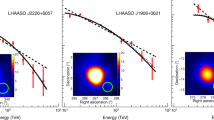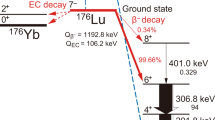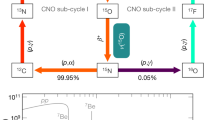Abstract
THE reaction Be9 γp Li8 was first observed by Ogle, Brown and Conklin1 in irradiations made with a 22-MeV. betatron employing counter techniques to observe the delayed β-particle emission from the lithium-8 and the α-particles from the beryllium-8. More recently, Baldwin2 has reported that the relative cross-section shows a maximum at 32-MeV. γ-ray energy. Because lithium-8 is unstable, the reaction proceeds by three stages:  and leads to the production of a three-particle star in photographic emulsions which are not electron-sensitive. Such stars have been observed in beryllium-loaded Ilford plates type C2 and E1 irradiated with 24-MeV. γ-rays from the synchrotron at this Establishment. Of the twenty-one events observed to date, that of highest energy is shown in the photomicrograph of Fig. 1, where the proton, recoiling lithium-8 nucleus and the two α-particles from the break-up of the beryllium-8* nucleus are visible. The distribution in range of the protons emitted is shown in Fig. 2, from which it will be seen that in about half the cases the proton escapes from the emulsion. As there are insufficient events to enable escape corrections to be applied, results on the variation of cross-section with energy cannot be given at this stage. However, the mean value of the cross-section over the energy-range 18–24 MeV. can be calculated from the results and is (2.5 ± 1.0) × 10−28 cm.2. In deriving this value, the density of beryllium in the emulsion was taken as 0.0079 gm./c.c. (a figure supplied by Messrs. Ilford, Ltd.), the theoretical spectrum calculated by Heitler3 was assumed and γ-ray intensity measurements with a thick-walled ionization chamber were employed.
and leads to the production of a three-particle star in photographic emulsions which are not electron-sensitive. Such stars have been observed in beryllium-loaded Ilford plates type C2 and E1 irradiated with 24-MeV. γ-rays from the synchrotron at this Establishment. Of the twenty-one events observed to date, that of highest energy is shown in the photomicrograph of Fig. 1, where the proton, recoiling lithium-8 nucleus and the two α-particles from the break-up of the beryllium-8* nucleus are visible. The distribution in range of the protons emitted is shown in Fig. 2, from which it will be seen that in about half the cases the proton escapes from the emulsion. As there are insufficient events to enable escape corrections to be applied, results on the variation of cross-section with energy cannot be given at this stage. However, the mean value of the cross-section over the energy-range 18–24 MeV. can be calculated from the results and is (2.5 ± 1.0) × 10−28 cm.2. In deriving this value, the density of beryllium in the emulsion was taken as 0.0079 gm./c.c. (a figure supplied by Messrs. Ilford, Ltd.), the theoretical spectrum calculated by Heitler3 was assumed and γ-ray intensity measurements with a thick-walled ionization chamber were employed.
This is a preview of subscription content, access via your institution
Access options
Subscribe to this journal
Receive 51 print issues and online access
$199.00 per year
only $3.90 per issue
Buy this article
- Purchase on Springer Link
- Instant access to full article PDF
Prices may be subject to local taxes which are calculated during checkout
Similar content being viewed by others
References
Ogle, Brown, and Conklin, Phys. Rev., 71, 378 (1947). Conklin and Ogle, Phys. Rev., 73, 648A (1948).
Baldwin, G. C., Abstract T11 Amer. Phys. Soc. Washington meeting, April 1949.
Heitler, W., “Quantum Theory of Radiation” (Oxford University Press, 1944).
Bethe, H., “Elementary Nuclear Theory” (John Wiley and Sons).
Franzinetti, C., and Payne, R. M., Nature, 161, 735 (1948).
Christy, R. F., Cohen, E. R., Fowler, W. A., and Lauritsen, C. C., Phys. Rev., 72, 698 (1947).
Goward, F. K., Titterton, E. W., and Wilkins, J. J., Nature, 164, 661 (1949).
Author information
Authors and Affiliations
Rights and permissions
About this article
Cite this article
TITTERTON, E. Photographic Plate Evidence for the γp-Reaction in Be9. Nature 165, 721–722 (1950). https://doi.org/10.1038/165721a0
Issue Date:
DOI: https://doi.org/10.1038/165721a0
Comments
By submitting a comment you agree to abide by our Terms and Community Guidelines. If you find something abusive or that does not comply with our terms or guidelines please flag it as inappropriate.



